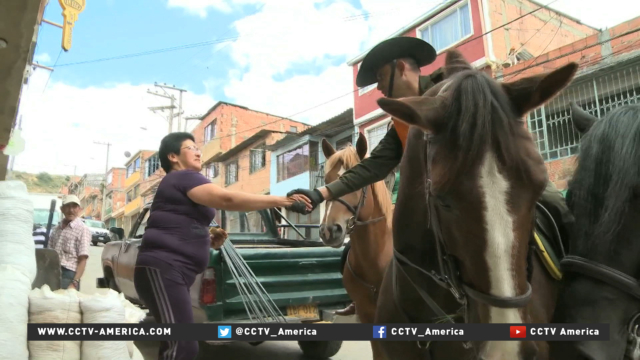Police on horses are making a comeback in South America. But not in idylic parks or for controlling crowds. Horseback patrols are being used to protect citizens in the most remote locations in Colombia. CCTV America’s Michelle Begue reported this story from Bogota, Colombia.

Major Luis Leon, commander of the Carabineros of Bogota, rides his steed Dionisis through the hills of Ciudad Bolivar in Bogota. This vast southern district of the city is home to more than 600,000 inhabitants and for years, poverty and state abandonment made this place a crime hub.
“This was a run-down place to consume crack. We patrol it, and try to keep it clean and safe,” Leon said.
The officers reach areas that no man, car or motorcycle could efficiently patrol because of the complex terrain. This is important in Ciudad Bolivar where more than 90 percent of its total area is mountainous, making it a perfect spot for drug addicts, gangs and traffickers in hiding.
“Another advantage, is the height of the horse,” Leon said. “It gives us a dominant vantage point of the terrain.”
A horse can quickly become an intimidating wild animal with its towering height of 1.70 meters, or 5.5 feet, and four strong legs that one kick could cause considerable damage.
Gentle horse Ilustre has gone through years of training to work in equine therapy, where horses are used therapeutically to enhance everything from physical, social and cognitive skills for people with disabilities. It takes at least four months for horses to be trained to these levels of domestication.
“We start by working with rationality and talk to the horse. We treat him well and caress him,” William Labrador Gomez of the horse therapy program at the National Cavalry School said. “Everyday we give him a treats: carrots, cheese, and sweets. That establishes a bond with the horse.”
Gomez and his horse of seven years, Erodio, lead the National Cavalry School program located in Facatativa, about an hour outside of Bogota. Erodio was born for this job as his parents worked with the Cavalry Police in Argentina.
“I think the most important part of being a Carabinero is my horse. For service, patrolling and presentations. He is my faithful friend and always with me,” Gomez said.
Displaying how loyal these horses are is key, to working with the patients.
Beautiful black Graffito shows how gentle he can be with humans, this way when the children finally begin horse therapy, they leave all their fears behind. The communication between the child and horse is not only important in horse therapy but also in working with the community.
“The horse is noble and kind and inspires those virtues in the community,” Gomez said.
While riding with the officers in Ciudad Bolivar the people receive them warmly. A sentiment that is echoed by locals young and old.
“They send a positive message to the community,” Alejandro Sanchez said. “Especially to the kids, whose attention is drawn to them.”
Citizens who choose to report their criminal activity is what help the police officers do their job Leon said
“When support and trust is generated in the community, people give us information, which helps with security,” Leon said.
 CGTN America
CGTN America

